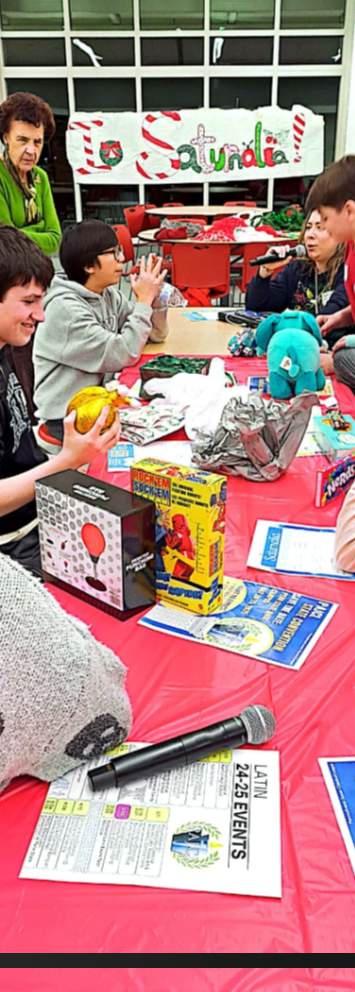




CONTRIBUTORS
CHARLOTTE MARLOWE
DENNIS DOUNAR
JULIA GREGG
KENDALL MUSGROVE
CHARLES DONECKER
KEVIN LIM
KRIS WATKINS
LAYA SUBMARANIAN
MATTHEW GREGG
MERIAH WILSON
SOPHIA VITELLA


EDITOR-IN-CHIEF
EMMANUELLE KRAMER
MANAGING EDITOR
VIOLET GORMAN
COPY EDITORS
SONJA MANHKOPF LAYA SUBMARANIAN
CONTENT DIRECTORS
SABRINA BAUER
NYLA BLITZ
PHOTOGRAPHERS
ARLO DALGARNO-PLATT
EDITORIAL BOARD
MARY JANE KOONS
TRACI DOUGHERTY
SABRINA BAUER
NYLA BLITZ
VIOLET GORMAN
EMMANUELLE KRAMER
TINYURL COM/UDSDJCL
Dear Readers,
Please enjoy our Winter 2025 edition of the PLUMA!
The PLUMA takes its readers on a journey through the world of Ancient Rome, putting them in the shoes of the Romans through articles and games written by the Latin students of Upper Dublin High School
Take a step into the world of Roman humor, history, business, and much more Learn about Roman shoes, holidays, art, markets, and even concrete! You’ll find Roman themed art and games Read stories written by our very own Latin students about a cook off between Athena and Aphrodite or what would happen if Icarus was an astronaut
This issue also includes information about the Upper Dublin High School and it’s officers. As about our past meetings, make sure you come to the next!
As you flip through the Pluma, I hope you enjoy the history, mythology, and games packed into this issue I also hope this issue of the Pluma encourages you to pursue your interest in Latin and continue learning about the Ancient World!

MANAGING EDITOR
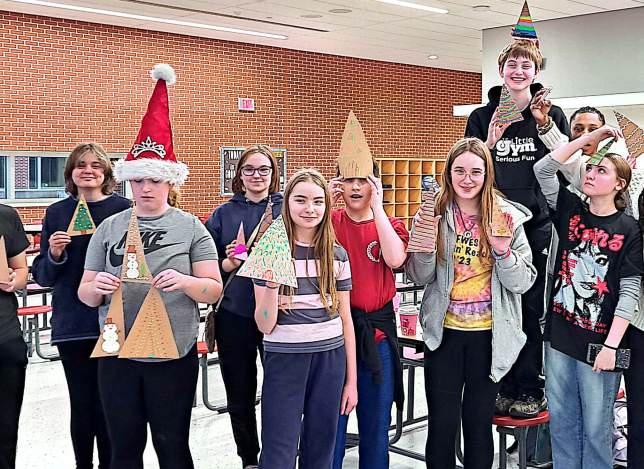
Cover image: Officer Tree, Upper Dublin High School, photo by Aiden Bray
Contributors image: Club Toy Drive, Upper Dublin High School, photo by Arlo DalgarnoPlatt.
Editor’s Letter image: Club December Meeting, Upper Dublin High School, photo by Arlo Dalgarno-Platt.
Back cover: Saturnalia Club Event Setup and Feasting, Upper Dublin High School, photos by Arlo Dalgarno-Platt.



Dive into a fun-filled section with comics, polls, artwork, certamina, games and more.
Analyze how the Odyssey combines history and storytelling to depict Greece.
Explore the evolution of shoes and their impact across ancient Rome to now.
Delve into the captivating story of
Explore
science behind long lasting Roman structures.
Winter Greetings from the Upper Dublin Latin Club!
The Upper Dublin High School Latin Club is excited to continue our momentum into the winter months, building on a highly successful fall semester
We've enjoyed impactful community outreach through food and toy drives, strong participation in new national contests, and the launch of our new website and social media accounts
This winter, we've been focusing on academic challenges with the Philadelphia Classical Society Art and Academic Contests, the National Latin Exam and a regional Certamen scrimmage We also took time to celebrate Roman traditions with a fun and educational Saturnalia event.
What’s New? Here are some of our biggest achievements from the past semester:
Organized a toy drive supporting those in need
Created a LIT window display to showcase our Saturnalia event
Achieved 4 Best of Show Awards in the Philadelphia Classical Society Art Contest
Earned 2nd Place for Club of the Month in November (NJCL)
Received Honorable Mention for Photo of the Month in December (see cover of the issue)

Here’s how you can get involved:
Schoology Group: Use the code 2XPW-9BC7-77NQ9 to stay informed Remind Group: Sign up for reminders with @udhslatin Membership Form: Don’t forget to complete the form to officially join!
Looking ahead, we’re excited for the spring field trips, including visits to the city of brotherly love, Philadelphia. We will continue to explore the rich cultural heritage of the ancient world in our local museums.
Let's continue to foster a community of learning and camaraderie as we look to a bright spring. We look forward to seeing you at our upcoming events!

CLUB SPONSOR
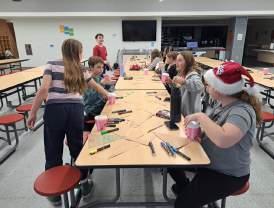


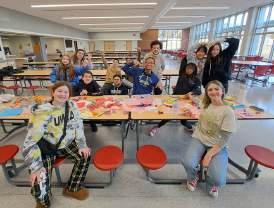
The Upper Dublin Latin Club has had an exciting and eventful winter semester, filled with hands-on projects, academic competitions, and celebrations of Roman traditions
December Highlights:
The holiday season brought plenty of festive spirit to Latin Club Members decorated paper trees at the December Club Meeting, adding a creative touch to the winter months. The club also organized a toy drive, giving back to the community while embracing the Roman value of caritas (charity). To showcase our feature event, students created a Saturnalia night-time scene in the display case, capturing the warmth and excitement of this Roman festival Our Saturnalia event was a night of games, food, and friendly competition, including Certamen, Santa vs Saturn chariot racing, and impromptu art and skits
January Highlights:
As we welcomed the new year, we laid the foundation quite literally for creativity and achievement Members kicked off the January Meeting with architectural ingenuity, constructing edible versions of ancient landmarks in a graham cracker build of the Roman Forum Magistra submitted fourteen entries to the National Junior Classical League (NJCL) Creative Writing Contest, showcasing students’ storytelling and classical mythology knowledge
February Highlights:
We were so excited to put a team together to enter the charity marathon volleyball tournament, but unfortunately, we were unable to gather enough participants. Members crafted Latin-inspired valentines and learned about ancient Roman love traditions in our February Meeting. What says LOVE more than a delicious mac and cheese feast? Latin students showcased their knowledge and creativity in the Philadelphia Classical Society (PCS) Art and Academic Contests.
With so many enriching experiences this winter, we are eager to see what the spring brings!
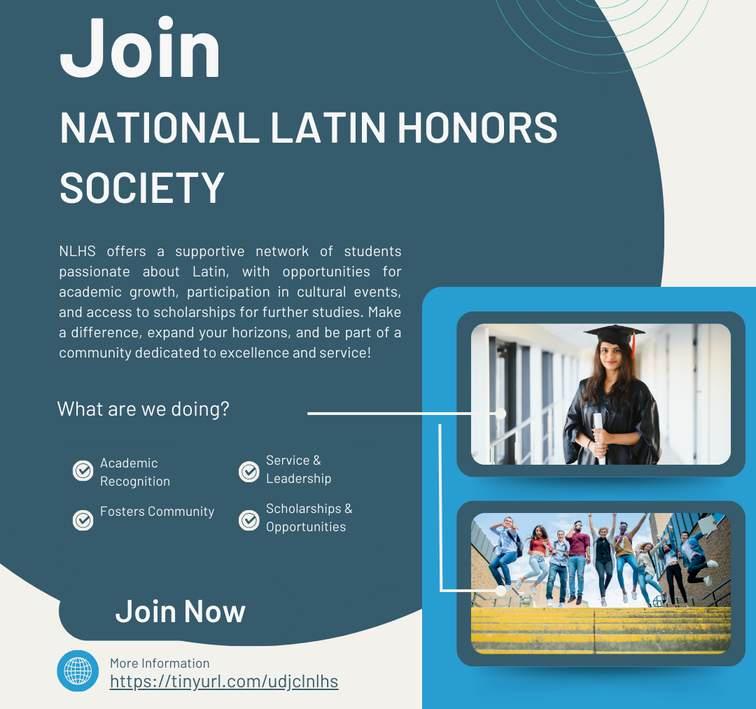
Hercules is known for his legendary Twelve Labors, each more daunting than the last. But which one was truly the most challenging? Cast your vote and help us decide the ultimate test of Hercules’ strength and wit!
Dennis Dounar is a 9th grade student at UDHS where he attends Latin 2. He has attended Latin throughout 7th grade to 9th grade. Apart from his interests in Latin he participates in Math club, Computer club, Chemistry club.


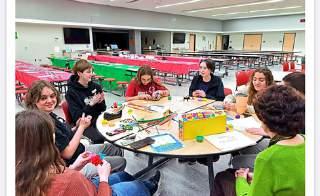
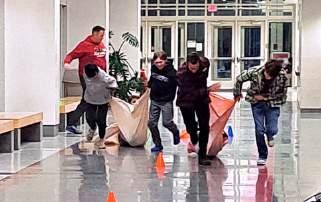

This year’s Saturnalia kicked off with the always-popular Certamen matches, where students competed in Latin trivia, testing their knowledge of ancient Rome Tension was high as teams of Upper Dublin students battled it out by level. Magistra joined the fun with several of the National Honors Society volunteers as TEAM CAESAR Pride and accomplishment were evident as students cheered on their classmates.
In addition to the intellectual challenges, students showcased their artistic talents in the impromptu art competition. With only pipe cleaners and limited time, participants captured the festive spirit of Saturnalia in unique ways The diversity of creations was truly remarkable, and the gallery of student work on display added a special touch to the festivities
The chariot races were another thrilling highlight of the event. All the major figures of the celebration got in on the fun - Saturn, after whom the event is named Santa, a related derivation, and Magistra Dougherty, the Chapter sponsor. With participants navigating their makeshift bedsheet chariots through a series of obstacles, the competition was fierce With teams strategizing and racing neck-and-neck, Saturn ultimately claimed victory in a thrilling finish
As the celebration continued, students and adults gathered for the decorated cookie competition. Students and judges cast their votes across the submissions, each with colorful icing, sprinkles, and festive designs Cookies were judged on taste, texture, appearance, and creativity The high school students swept the competition Top scoring cookies included shortbread cookies decorated into chocolate trees, chocolate mint cocoa cookies, and the ever popular peppermint jollies

p decals onto their shirts, allowing them to leave the event with a personal memento of the day The shirts were a fun and creative way to commemorate the celebration and showcase the students' love for Latin and Roman culture
Of course, no Saturnalia celebration would be complete without a bit of feasting, and Upper Dublin students were able to indulge in delicious pizza and treats throughout the event The spirit of generosity and merriment, much like the ancient Roman holiday, was alive and well as students enjoyed the festive atmosphere.
The Saturnalia celebration was a wonderful reflection of Upper Dublin’s Latin program, showcasing the students’ dedication to both learning and having fun As the event came to a close, students left with smiles on their faces and a sense of accomplishment in their hearts.
We look forward to welcoming everyone back next year for another unforgettable Saturnalia celebration!




Test your knowledge of Roman culture with this exciting Strands Game!
Explore the fascinating world of Roman life, including their food, clothing, housing, and family traditions Do you have what it takes to master the challenge?
Connor Reece is a student at Upper Dublin High School in 9th grade. He is currently in Latin II and will most likely continue to take Latin throughout his years at high school. Outside of Latin, he is interested in graphic design and music.
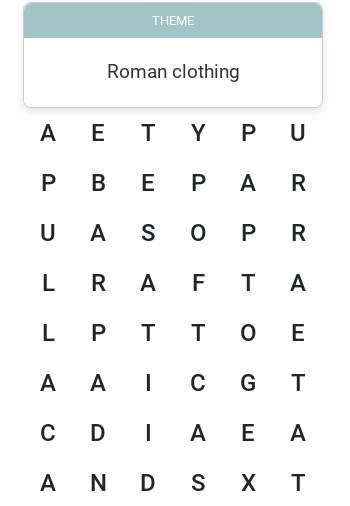
In mythology, death is only the beginning This comic follows a lost soul’s eerie descent, from Charon’s ferry across the Styx to Cerberus’ three-headed glare, meeting Proserpina and Pluto along the way. With a mix of humor and dread, it captures the strange fate that awaits in the afterlife.
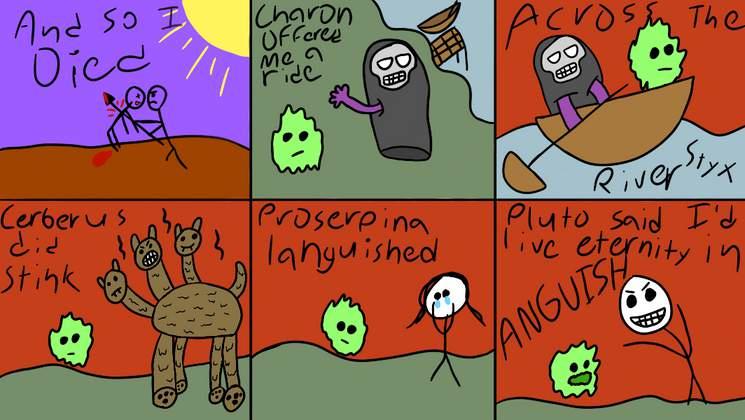
Charles Donecker is a 11th grade student in Upper Dublin High School in latin IV honors. He is in the robotics club He is really cool because he does that. And he also does school work like homework and studying for tests. He is passionate about video games because that is what he does outside of school in his free time.


I LOVED THE FUN ACTIVITIES THAT LATIN CLUB DOES AND I ENJOYED LEARNING ABOUT COOL THINGS, AND OF COURSE WE ALWAYS HAVE THE BEST FOOD TO EAT AND PEOPLE TO MEET!
MY FAVORITE LATIN CLUB MEMORY IS GOING TO SEE HADESTOWN AS A CLUB AT THE ACADEMY OF MUSIC IN PHILLY.

I LOVED PERCY JACKSON IN MIDDLE SCHOOL, AND FIGURED LATIN WAS A GREAT WAY TO STUDY THE MYTHOLOGY I LEARNED FROM IT PLUS, LATIN CLUB SEEMED PERFECT FOR MEETING INTERESTING PEOPLE, AND WE ALWAYS HAVE GREAT FOOD (WE ACTUALLY BOUGHT AN ENTIRE SHEET CAKE FOR ROME'S BDAY).
THE PREZ V PREZ CHARIOT RACE™ AT SATURNALIA (SABRINA WON) AND "LATIN-THEMED" KARAOKE.




EditorinChief
LANGUAGE THAT'S THE FOUNDATION FOR OTHER LANGUAGES. LATIN CLUB HAD A L FUN ACTIVITIES LIKE PUMPKIN PAINTING MYTHOLOGY TRIVIA, SO HAVING A GOOD WAS ALSO MOTIVATION.
THE MURDER MYSTERY PARTY DURING TH OF MARCH MEETING
Treasurer
I INITIALLY TOOK LATIN BECAUSE I THOUGHT IT WOULD HELP WITH THE SAT VOCABULARY (AND IT DID!), BUT I GREW TO LOVE THE LANGUAGE AND THE LATIN FAMILY OVER TIME
MY FAVORITE LATIN CLASS MEMORY IS OUR AMERICA’S GOT TALENT CAMEO

They took the structure of the Babylonian zodiac and blended it with their own mythology and culture. Roman deities were assigned to each of the twelve zodiac signs This made the zodiac relatable to Roman citizens as well as providing symbolic meaning that reflected Roman values. The Romans also developed horoscopic astrology. Horoscopes were drawn depending on the position of celestial bodies at the time of the person’s birth
Emperors often consulted astrologers to seek guidance when making political or personal decisions. Emperor Augustus used his sign, Capricorn, to prove his right as a divine ruler of Rome As the zodiac grew in importance, it was found in art and literature throughout Ancient Rome It was appealing to those in all social classes creating common ground between the people of Rome
“As we carve pumpkins and go trick-or-treating, we're continuing traditions that span millennia, rooted in ancient Celtic and Roman customs."
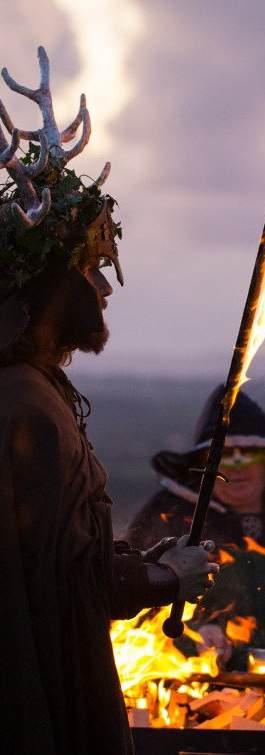
The Roman tradition of astrolog intertwined in today's popular cu has gained huge momentum as refer to their sun signs, read hor or guidance, and use zodiac-inte fashion, art, and media Similarl fascination with astrology reflect use of astrology as a means of g source of inspiration.
The Romans had a vital role in m zodiac system and popularizing practices that have carried well era. By blending astrology into t everyday life, and political syste a foundation upon which we bas understanding and relation to th The Romans' contribution to ast a lasting impact on people's und connection between human life

Astrology in Ancient Rome was an important piece of their political and cultural world Although astrology can be traced back to earlier civilizations such as the Babylonians and Egyptians, the Romans transformed it into something even greater.
Meriah Wilson is a 10th grade student at Upper Dublin High School and a member of Latin Club, where she serves as Co-Webmaster. Meriah has earned Thespian status in Drama Club and enjoys creative projects.



Sophia Vitella is a proud 10th grade Latin III student at Upper Dublin High School. In her free time she participates in Field Hockey, Swimming, and Softball. She is a very well rounded individual.

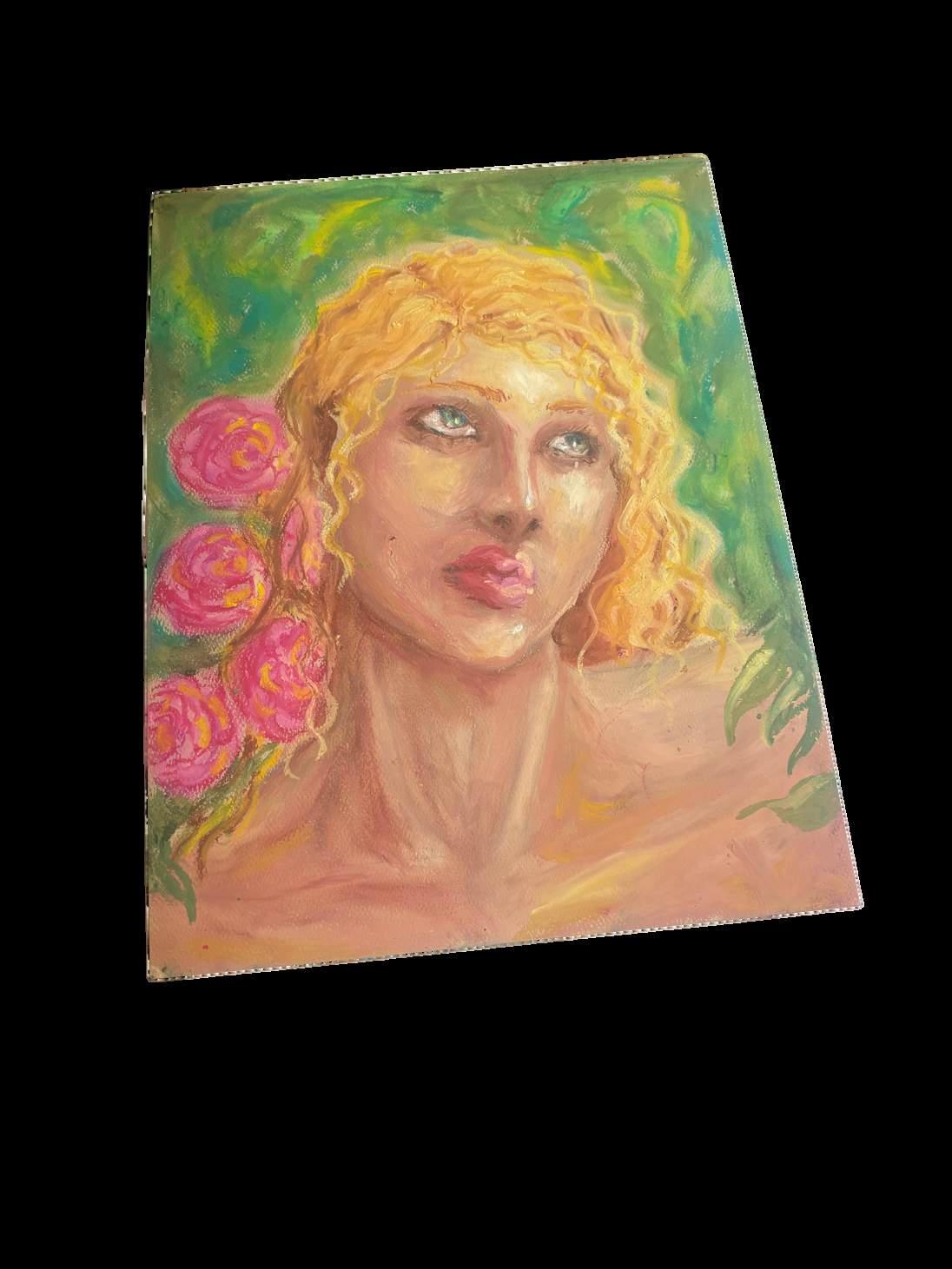

Kris Watkins is a 9th grade student at Upper Dublin High School. He is a member of the Latin Club and the UDHS Choir. In his free time, Kris enjoys 2D art, and writing media analysis and film reviews.
Laya Subramanian is a sophomore at Upper Dublin High School. She likes to play tennis, is a part of the orchestra, and a Scout. She plans to pursue a research career after school.
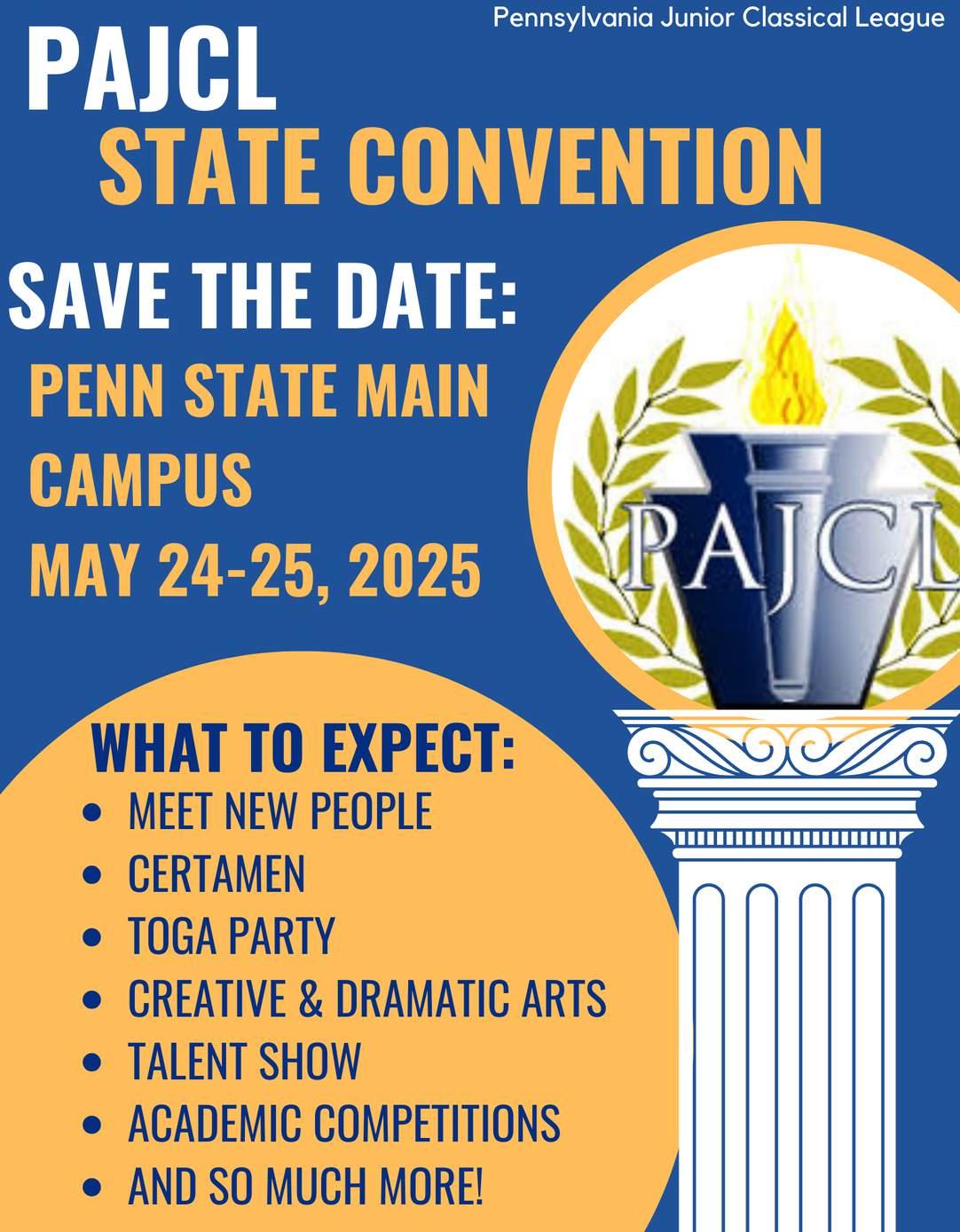
The bustling markets of Ancient Rome were more than just places of trade; they were the heart of economic and social life, laying the groundwork for modern commerce By tracing the evolution of Roman trade practices, we gain insight into the lasting foundations of our modern economy This topic is not only historically intriguing but also relevant for understanding the foundations of our current global economy.
Roman trade practices, currency, and banking were advanced for their time period. Romans established networks that spanned the Mediterranean and beyond The Roman Empire's vast infrastructure facilitated the movement of resources such as grain, spices, wine, olive oil, glass, and luxury items like silk The use of sophisticated banking systems and standardized currency opened the door for efficient and widespread economic activity The Roman’s innovations laid the foundation for the complex trade systems we see today.
While Romans didn’t invent money, their system of standardized currency played a crucial role in shaping modern economies They can claim the word origin, however, as the English word derives from the location of Rome’s first mint: the temple of Juno Moneta” (Deahl). This name is a reflection of the local devotion to a goddess named Moneta, who ultimately transformed into the god Juno, Jupiter's wife. After the Roman era, what had once been a remnant of religious worship came to represent a mint and, eventually, money in society
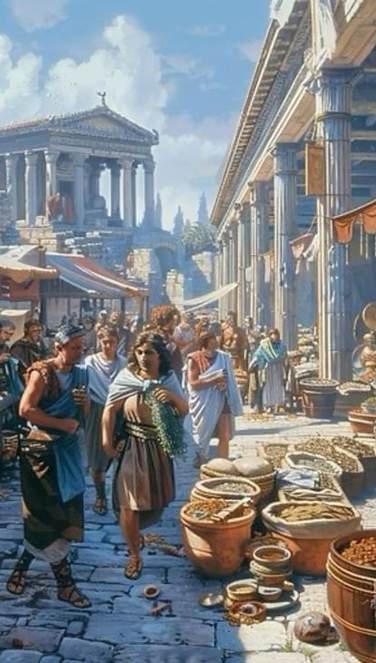

The ancient Romans were pioneers in creating "banknotes" long before modern paper currency! While we usually think of coins when we imagine Roman currency, the Romans used a form of promissory notes, called "accepti" , which were used by merchants to guarantee payments across long distances.

The use of a common currency was a key aspect of Roman trade, which simplified transactions and reduced the threats and risks associated with barter This is similar to the modern use of standardized currencies like the US dollar or the euro, which facilitate international trade. Additionally, Roman banking practices such as the creation of banking houses and the use of promissory notes served as precursors to modern banking organizations and financial systems
For instance, the Roman Empire's trade networks can be likened to today's global supply chains Goods from distant regions were transported to Rome, much like how products are shipped globally today. The Roman practice of using contracts and legal agreements to ensure fair trade and protect investments is mirrored in modern business practices and international trade laws Furthermore, the concept of a centralized market, such as the Roman Forum, has evolved into today's stock exchanges and financial hubs
The continuity of economic principles and the innovations that have been built upon them throughout centuries are highlighted by an analysis of these historical activities. The efficiency and magnitude of Roman trade demonstrate how crucial infrastructure, established procedures, and legal frameworks are to trade facilitation We can appreciate the lasting legacy of Roman innovations and their influence on current global trade by grasping how ancient commerce affected the economy today This viewpoint not only enhances our comprehension of economic history but also offers insightful knowledge regarding how today's trade practices have evolved
When two of the most powerful figures in Greek mythology compete, you’d expect to see dramatic battles with swords and shields But today, things are a little more domestic
In a surprising twist of fate, the iconic goddesses of love and wisdom have been pitted against each other in a bake-off that’s sure to stir up some divine rivalry The theme?Greek mythology, of course The stakes? Immortality is one thing, but with a golden whisk trophy could mean the ultimate bragging rights. When gods bake, even the flames of Mount Olympus can't compare to the heat in the kitchen!
On one corner, there is Aphrodite, the goddess of love, beauty, and everything beautiful in the aesthetic perspective
Aphrodite knows how to captivate, whether through charm or culinary creations And that is really the same philosophy behind her baking: it is much about the presentation as the taste. She will bake something which, rather than just delighting your palate, is guaranteed to make one fall in love at first bite.
The Challenge
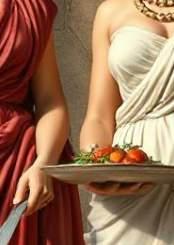
In the other corner, there is Athena She stands as the goddess of wisdom, strategy, and war, she equally is a discipline of the mind-where she is absolutely about precision, just like precision would have it. She is less worried about impressing you through an aspect of beauty but rather that every ingredient has its place and steps perfectly in calculation.
Athena sees in an ideal baking demonstration no less than in cooking skills the display of intellectual strength
The Challenge is to concoct a 3-course meal displaying their prowess. Strategy, creativity, and mythical flair at play-the clock starts ticking Let the baking begin!
Aphrodite starts off the race with an edible bouquet of roses glazed in honey syrup, finished off with a sprinkle of pomegranate seeds on top Visually, this is stunning in shades of pink, petals placed artfully upon a silver serving plate, almost intoxicatingly scented Smiling serenely, Aphrodite sets her delicate dish with a sure knowledge that the visual will make the judges swoon "Isn't beauty the highest form of love?" she muses as she finishes with a flourish. But will it hold up in terms of taste? Only time will tell
Athena's is, really, more practical Her dish? Olive tapenade, of the finest olives from the groves of Mount Olympus, well mixed with capers and lemon zest Athena's dish is as divine as effective-a well-crafted appetizer that testifies to the wisdom of the gods "Taste comes from simplicity," she says, arranging the dish on a plate with military precision. No fuss, no musspure flavor
First taste by the judges: the roses by Aphrodite, sweet, and they are lovely-sweet as it is-again, though almost too flowery and floral, almost a little perfumelike in nature; whereas Athena made the tapenade masterfully deep yet rich with refreshing effect
Athena wins round one for precision, while Aphrodite impresses with presentation
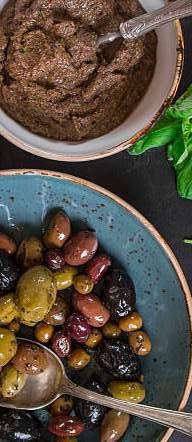

The judges, who had tasted the two sweets, really had a hard time making their decision Indeed, there was nothing wrong with Aphrodite's honey cakes; they tasted fine, but Athena's tartlets somehow married their flavors in a most satisfyingly surprising way This rare turn of events, the judges declare this round a tie-for Aphrodite's cakes, since they were divinely sweet, and for Athena's tarts, since they showed such intellectual balance
Indeed, with three such grueling rounds, one thing would have been for sure: the goddesses sure brought their A-game along Aphrodite, of course, shone bright with all her beauty and indulgence, while Athena had it all in her power of precision, poise, and strategy And here comes the verdict The judges declare a tie; hence, the divine bakeoff finally gets over with a note where both goddesses are holding the golden whisk trophy.
Aphrodite leans in and whispers, "I guess beauty does pay in the end "
Athena just smirks. "Balance does every time " As the gods and goddesses of Olympus toast their gastronomical feats, one thing is certain: in baking, there is no such thing as a perfect recipe-except when both love and wisdom are the ingredients


And here is where things get really interesting with Aphrodite She does lamb with figs and honey-what can only be described as truly indulgent, high-living. Tender the lamb is caramelized with honey, each bite carrying its sweet decadence Aphrodite sprinkles on top a few rose petals; she knows full well even a dish that's savory needs to have romance
"You can never have too much beauty in the world," she says, winking, setting the dish before the judges Athena is one who doesn't shy away from complexity, and thus stuffs grape leaves with lamb and rice, encasing them in the finest leaves taken from her personal garden in Athens
Each roll was identically perfect to the others, delicately packed and seasoned with herbs and a touch of feta. It was a dish that spoke volumes of her strategic mind: every bite a balance of flavors, with every element aligned in relation to one another Athena is confident "Perfection needs deliberate calculation," she says, adjusting her plate
With each judges’ tasting, it becomes obvious which direction the competition has taken The lamb from Aphrodite was rich, overindulgent, but almost crossing into too-muchness. On the other hand, Athena's grape leaves were really a triumph of technique, with each subsequent bite more pleasing than the last Athena wins again in this round, though one could not deny the charm of Aphrodite

If there is one round where Aphrodite can dominate, it is dessert. She has a sweet tooth, and now it's time to bring in the big guns And so, Aphrodite prepared honey cakes, each one topped with edible glitter in sprinkles of gold and candied rose petals with care Light, fluffy, sweet-the very essence of decadence Presentation perfect, flavor intoxicating. She places them on the table with pride and says, "The sweet is in the love inside "
Meanwhile, Athena approaches dessert with the same intellect and strategy as her other courses: she bakes tarts of fig and walnut, each cut to perfect specification, the pastry buttery and flaky, the filling perfectly balanced between figs, honey, and walnuts Athena's tarts were all about balance-sweet but with a touch of savory depth. "Wisdom teaches that indulgence must always be balanced by restraint," she says, arranging her tarts
BY MATTHEW GREGG
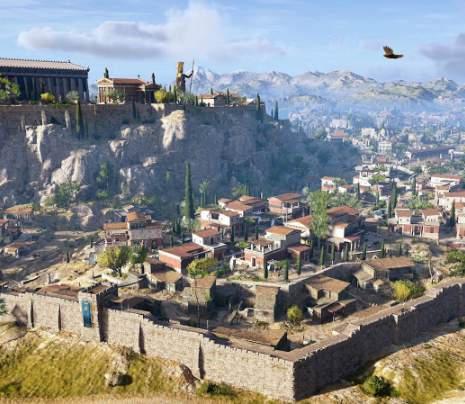
Imagine walking through the bustling streets influence on Western civilization, are central to the game and historical reality Comparing the game’s portrayal of ancient Greece to its real counterpart: standing before the grandeur of the Parthenon or debating philosophy with Socrates himself.
In Assassin’s Creed Odyssey, players are transported to ancient Greece in a way that blends breathtaking historical detail with imaginative storytelling But how does this digital depiction compare to the real history it draws from?
Assassin’s Creed Odyssey offers players an immersive journey through ancient Greece, blending historical accuracy with creative liberties to craft a vibrant digital map
“Meeting Socrates in the game was a highlight for me—his clever dialogue mirrored the philosophical debates we read about in textbooks, making history feel alive and interactive.”
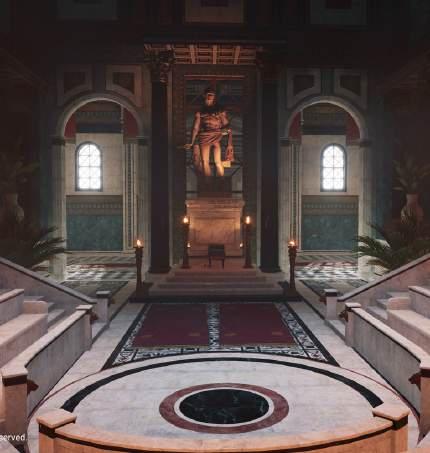
Greek architecture and culture, celebrated for their elegance, serve as the foundation of Odyssey’s immersive world though with some creative liberties taken for game play
Greek architecture, particularly the Doric, Ionic, and Corinthian styles, is faithfully represented in the game’s recreations of landmarks like the Parthenon in Athens and the Temple of Apollo at Delphi The game captures the symmetrical columns, pediments, and decorative friezes of these structures with stunning detail. However, Odyssey takes liberties with scale and geography, compressing regions like Athens and Sparta to enhance accessibility and exploration. These changes ensure players can interact with cultural landmarks without lengthy travel but occasionally sacrifice realism
Cultural elements such as mythology, politics, and daily life are also richly incorporated into the game. Players meet historical figures like Pericles and Socrates while engaging with mythical creatures such as the Minotaur and Medusa
This blend of fact and fiction transforms symbolic myths into interactive game play, bringing ancient storytelling to life Additionally, AC Odyssey portrays vibrant markets, philosophical debates, and theatrical performances, showcasing the intellectual and communal aspects of Greek society. However, the game often idealizes these elements, overlooking realities like slavery, inequality, and political exclusion For example, while Athens is depicted as a beacon of democracy, the exclusion of women, slaves, and non-citizens from political life is downplayed.
In conclusion, Assassin’s Creed Odyssey provides a visually stunning and culturally rich depiction of ancient Greece, capturing much of its architectural grandeur and societal vibrancy
While the game embellishes certain elements for entertainment, it effectively highlights the legacy of Greek culture and inspires curiosity about one of history’s most influential civilizations By blending historical accuracy with creative freedom, Odyssey bridges the gap between education and entertainment, inviting players to explore the true stories behind its digital landscapes Ultimately, Assassin’s Creed Odyssey is more than a game; it’s a gateway to history. Whether marveling at its architectural recreations or debating with Socrates, the game invites players to imagine the lives of those who shaped one of history’s most influential civilizations What stories will you uncover when you dive into ancient Greece?
Matthew Gregg is an AP Latin student at Upper Dublin High School. He serves as treasurer of the Latin Club and is an active Boy Scout. Matthew enjoys bowling, ultimate frisbee, and tennis, and he plans to study nuclear science or engineering in college.


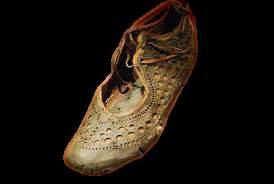
Shoes have long been a part of our society, beginning with the necessity to protect the feet and evolving into an important fashion implement. In ancient Rome, footwear ranged from simple sandals worn by common citizens to ornate versions studded with amulets and sported by the elite.
Made from leather cords braided onto a sole, the sandals, or “soleae”, kept the toes uncovered and comfortable in the hot Roman climate They were practical and affordable, allowing all people, even the slaves, to own them. The wealthy Romans, however, wore more expensive, dyed, and adorned sandals that signified high status Gladiator sandals were worn by both gladiators and Roman soldiers Made from strong, tanned leather, and studded with hobnails for grip, the gladiator sandals were sturdy and useful in battle
Today, shoe wear is all the hype, with many brands such as Nike, Adidas, and Brooks designing shoes for comfort in everyday use and virtually every sport imaginable These everyday shoes are comparable to the standard sandals of the ancient Roman civilization in that everyone wore them and they were practical
Brands like Yeezy, Prada, Hugo Boss, and countless others have shoes designed for the wealthy and worn only for special events This designer side of shoes is comparable to the dyed sandals of the elite Roman class in that it displayed one’s wealth effectively
Shoes today have come a long way in both technology and specialized uses outside of everyday life Comfort has evolved from the stiff leather soles to materials such as foam and rubber. Still, sandals reminiscent of the ancient Roman period remain popular in society, as well as the purposes and social aspects of the shoe.
Kevin Lim is a junior at Upper Dublin High School, currently enrolled in Latin IV Honors. He is a member of the Environmental Education Club and Science Olympiad, and he also competes in cross country and track while playing double bass in his local youth orchestra.

Icarus stood on the threshold of the aircraft, teetering on the edge of space The endless void seeped into every corner, like an onyx blanket wrapped infinitely around the universe The silence was stale and claustrophobic; nonetheless Icarus loved it The grandness of space made him feel free from all the obligations and expectations from his father, Daedalus. Icarus was young and filled with spirit and the eagerness to prove himself Growing up he experienced firsthand his father's supreme intelligence, which fostered deep insecurities within himself. Unlike his father, Icarus was not brilliant and felt the pressure of others' expectations to be a prodigy like Daedalus Icarus had joined the space agency in order to make his father proud and move out of his shadow. What he didn’t realize was that his desperation for Daedalus’ validation blinded him from seeing his father’s true feelings of unconditional love Striving recklessly to be accepted would ultimately be the cause of Icarus’ demise.
Daedalus, a cautious man was the opposite of Icarus He was well-seasoned in life and had experienced many trials and tribulations, as well as deep regret. He was haunted by the blood on his hands from the attempted murder of his nephew Talos Talos had been learning under Daedalus and quickly started to overshadow him in intelligence Daedalus began to fear that he would become the former genius of Athens and Talos’ reputation would eclipse his This insecurity and jealousy drove Daedalus to push his nephew off the cliff of the Acropolis Talos survived the treacherous incident and was so scarred by the experience that to avoid ever falling again he became a pilot for the rest of his life

Daedalus was tried for his actions and banished from Athens To escape his past he found refuge in Crete where he met Icarus' mother, Naukrate, who was a servant for the president Minos. Daedalus hoped that he would be able to raise his son not to make the same mistakes he did as a young man Soon after settling in Crete with his new family, Daedalus and Minos became close companions. Minos was highly impressed with Daedalus's intelligence and creativity and invited him to join the Italian Space Agency There, Minos tasked Daedalus with a special project, designing a maze in space meant to contain a horrible monster called the Minotaur. Created in a lab for the research of genes and DNA, the minotaur was a mutated creature with the body of a man and the head of a bull The head of the bull could only scream, no longer able to speak the human language, and while it had the physique of a man, it was as strong as an animal The experiment had gone terribly wrong and led to an accident with Mino's wife, Pasiphae. The Minotaur had broken out of the lab and had targeted Pasiphae, injuring her severely
Minos didn’t want to kill the Minotaur but wanted to keep it trapped in a maze in space so that it would never be able to hurt his wife again Daedalus had agreed to build such a labyrinth Little did he know that Minos had planned to double-cross him and throw him and his son Icarus into the maze as well. Icarus took a deep breath and smiled His father, having already jumped, was waiting for him This was the day they were finally escaping the labyrinth with the brilliant contraptions his father had built them. Solar gliders consisting of overlapping metal tiles like the feathers of a bird would power them through space to the closest space station Solar gliders consisting of overlapping metal tiles like the feathers of a bird would power them through space to the closest space station
Knowing of the dangers, Daedalus had carefully tethered themselves to the ship containing the maze as they jumped into the void He was determined to free Icarus from the labyrinth and keep him safe. Once they reached another space station they could start a new life While instructing Icarus, Daedalus had stressed not to put excessive force on the tether or overexert the gliders However, his warning fell on deaf ears Icarus took a running leap out into the void. His body floated effortlessly into space, his eyes wide as he took in the dangerous beauty of the solar system Icarus was eager for his first space walk so that he could prove to his father that he was brave and capable. Out of paternal love Daedalus called out to remind him again of the importance of the tether but Icarus heard his words as a rebuke instead


The tether felt like a restraint, like training wheels, like his father didn’t trust him, didn’t believe that he could do it on his own Icarus released the tether Unencumbered by his father's restrictions, he flew as fast as he could, the solar glider shimmering and shuddering under the strain His father's cries of fear were not heard through the adrenaline pumping through his ears He knew his father was watching him now, seeing his strong and confident flight. The gliders were not meant to withstand the speed Icarus was challenging them Instantly, a deafening crack sounded and Icarus' smile dropped from his face
“His body floated effortlessly into space, his eyes wide as he took in the dangerous beauty of the solar system.”
He screamed his father's name but it was too late. The solar glider broke apart, the metal tiles scattering like feathers Daedelus was too far to reach his son Icarus was lost and alone forever floating through the endless space. Only now did Icarus recognize the love behind his father's warnings but the realization came too late All of Daedalus’ plans had in fact been for him and that he had been his father's greatest pride
Like the myth, this retelling reminds us that ambition without caution can lead to a fall even among the stars

“Nonscholaesedvitaediscimus.” “Welearnnotforschoolbutforlife.”
AgendaandConventioneventsLiliaAitSahlia,NJCLPresident| president@njcl.orgElizabethBouis,ConventionAdvisor| convention@njcl org UniversityandLocalMatters
AmyElifrits,ConventionCo-Chair|abelifrits@yahoo com
EmelieInderhees,ConventionCo-Chair|inderhees@wellington org ToddWegenhart,ConventionCo-Chair|programs@njcl.org
Cost:TBD

Sherwin Little, Convention Registrar littles@aclclassics org P. 513-529-7741 | F: 515529-7742
The Roman Colosseum, one of the New Seven Wonders of the World, with its majestic, bounding arches, and rows upon rows of stands circling an epic arena, is visited by nearly seven million people yearly. It’s hard to imagine that this marvel, which was built circa 80 AD, still stands strong in the center of Rome. Unlike many modern buildings, which may only last a few decades, the Roman Colosseum and other ancient structures like the Baths of Caracalla or the Pont du Gard aqueduct have endured for millennia What’s their secret?
Roman concrete — a material so advanced it seems almost magical, yet it’s all chemistry.
Roman concrete is made of mostly the same materials that modern concrete is. But the Romans’ concrete was made to interact with its environment Scientists have found that the mixture contained lumps of quicklime, or calcium oxide (CaO) This used to be dismissed as sloppy mixing of the material, but it could actually be the key to the longevity of their buildings
Quicklime, a highly reactive material, binds with water to form calcium hydroxide (Ca(OH)₂), which crystallizes and fills cracks on its own Like a living material, Roman concrete repaired itself over time, growing stronger instead of weakening For Roman concrete, this couldn’t be more true.
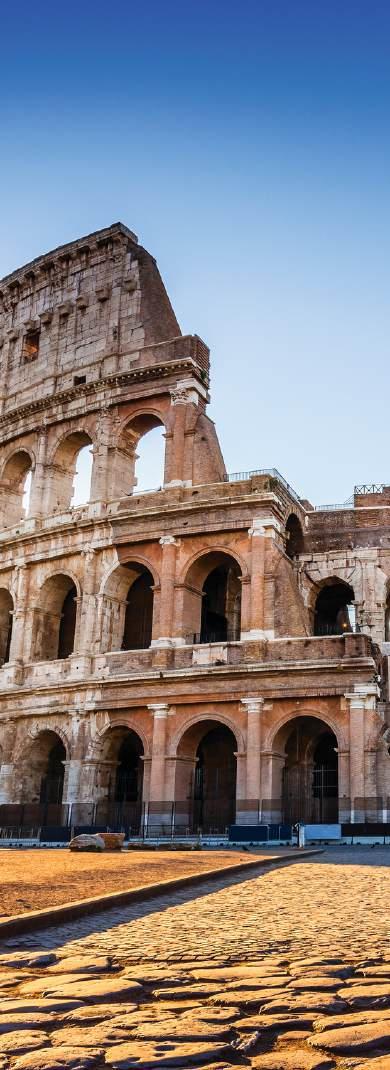
“ROMAN BATHS OFFERED A HUGE VARIETY OF EXPERIENCES, WHETHER IT BE HEART-RACING AND BLOOD-PUMPING EXERCISE OR A WARM AND STEAMY STAY IN A CALM-INDUCING CHAMBER.”

The mixture also includes a type of volcanic ash from Pozzuoli, Italy, which reacts with seawater and actually strengthens the structure over the years. So structures near the sea, instead of just eroding, would become even more secure The special mixture was also more environmentally friendly. It took less energy to heat and left a much smaller carbon footprint than our modern day process
So, why not use this amazing concrete today?
There are some drawbacks to the Romans’ magical concoction One, it takes a longer time to set, meaning construction wouldn’t be as fast. Also, because the concrete relied on time to strengthen it, it likely wouldn’t be able to withstand our modern uses for it in its first years. Lastly, we don’t exactly know the details of the ancient recipe enough to replicate it, and the volcanic ash is from a very specific location making it not readily available enough. The special concrete could be useful, though If scientists can unlock the full potential of Roman concrete, it may revolutionize sustainable construction in the future


CO-CONSULS
SABRINA BAUER
NYLA BLITZ
CO-VICE PRESIDENTS
NOELLA CARLO
EMELYN RUDALAVAGE
CO-WEBMASTERS
MERIAH WILSON
STEPHEN SENA
CO-COMS COORDINATORS
AIDEN BRAY
MOLLY PERMAR SECRETARIES
JACEN GLASSMAN
OPENING EDITORS
EMMANUELLE KRAMER
VIOLET GORMAN (ELECT) TREASURERS
MATTHEW GREGG
JULIA GREGG (ELECT) HISTORIANS
ARLO DALGARNO-PLATT
MORGAN KEATON (ELECT)
Pluma is published quarterly as the publication of Upper Dublin High School Latin Club and Junior Classical League Chapter
Dedicated to showcasing the creativity, scholarship, and unique perspectives of our vibrant community Our mission is to ignite curiosity, foster collaboration, and amplify the diverse talents of our students and the modern relevance of all things ancient
SHARE YOUR VOICE AND CREATIVITY BY SUBMITTING ARTICLES, ARTWORK, OR IDEAS TO BE FEATURED IN OUR STUDENT PUBLICATION.
SPREAD THE WORD BY SHARING OUR PUBLICATION WITH YOUR FRIENDS, FAMILY, AND COMMUNITY.
STAY INFORMED AND INSPIRED BY SUBSCRIBING TO RECEIVE OUR LATEST EDITIONS DIRECTLY IN YOUR INBOX.
